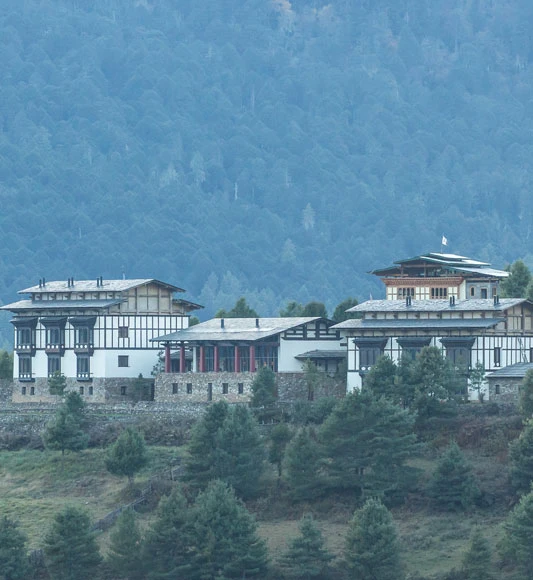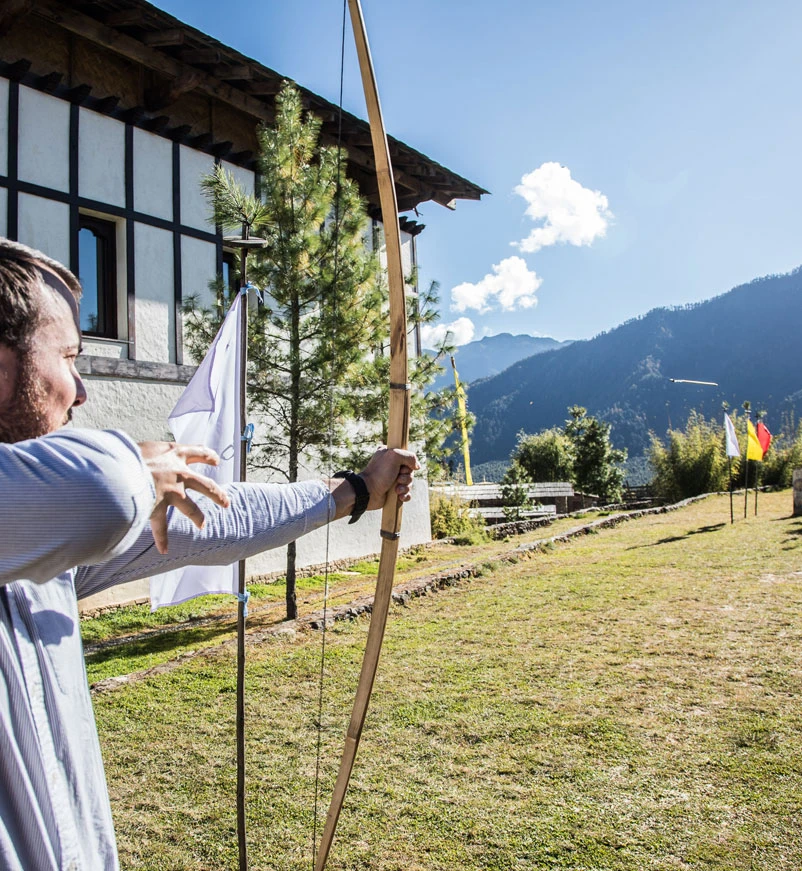
Stay at Gangtey Lodge for mesmerising views.

Become immersed in the spiritual side of Bhutan.
Why visit Bhutan?
To this day, Bhutan is a destination shrouded in mystery; one of the few places left in the world that is still reluctant to move with the times. Sandwiched between India and China, Bhutan is predominantly Buddhist and has just 800,000 citizens. What I love most about Bhutan is that around every corner there are picturesque dzongs (fortresses) and chortens (shrines), evergreen landscapes that stretch for miles, iridescent rivers and the sound of prayers which seem to hang in the air. It is a truly special place.
It is well-known that Bhutan prefers to base its success on its Gross National Happiness over its Gross Domestic Product. This provides a fascinating insight into how much the country values its people. However, it’s Bhutan’s cultural heritage which really resonated with me on my most recent visit. At the core of Bhutan’s culture lie the 13 arts and crafts, known as Zorig Chusum, which are deeply rooted in Buddhism. Taught from a young age, you’ll find teenagers studying calligraphy, sculpting, embroidery and masonry to name just a few. I also adore Bhutan’s respect for all living organisms. For example, a law states that at least 60% of the country must be forested at any time. They place great importance on healthy environments – I was personally amazed at the clarity of the rivers and the fresh and clean feel of the air.
Highlights of exploring Gangtey Valley in Bhutan

Gangtey Lodge is the perfect blend of luxury, adventure and spiritual enlightenment.

Go hiking and stop for a picnic accompanied by 360-degree views.

Relax and unwind back at the lodge.

Spend time with the monks and learn about their local Buddhist traditions.

Receive a personal blessing from the Tulka (reincarnated Master).
"I recommend participating in the Tshewang Prayer with monks and lamas in the Monastery, before receiving a personal blessing from the Tulku (a reincarnated Master)."
Where to go in Bhutan?
In an ideal world, you would make multiple stops in Bhutan to gain a fuller understanding of the country and its traditions and history. However, we know time is precious and you may only be able to visit Bhutan for a short time. If this is the case, there is one stop that I highly recommend you make.
Perched high above the pristine nature reserve of Phobjikha Valley, Gangtey Lodge is a charming twelve-bedroom lodge with stunning design and spectacular views. Quaint and homely without compromising on service or luxury, Gangtey Lodge has over 50 staff to ensure that all your needs are met. Designed to blend in with the traditional Bhutanese farmhouses that dot the area, the lodge has been built – and is operated – to the highest standards of sustainability. Local and recycled materials were used during construction and all wastewater is recycled and food waste is composted.
The Lodge showcases ornate local woodwork whilst effortlessly blending indulgences such as Swedish log-burning stoves and English roll-top baths set under the expansive windows so you can admire the glorious valley views whilst you unwind.
There are no televisions here and guests are encouraged to connect with the local environment and cultures instead through the Lodge’s “5 Keys To Well-being”.
5 keys to well-being in the Gangtey Valley
1. Nature:
Gangtey (or Phobjikha) Valley has to be one of the most stunning destinations in Bhutan. At some 3,000 metres above sea level, Gangtey is a glacial valley on the western slopes of the Black Mountains and is a designated conservation area bordering the Black Mountain National Park. Many visitors have marvelled at its beauty, and it is often described as “the most beautiful spot in the most beautiful country in the Himalayas.” A fine testimony indeed! During my stay, I enjoyed exploring the ancient hiking trails which wound their way through beautiful blue pine forests. Should you prefer, you can also explore the valley by mountain bike.
The valley is the winter roosting grounds of the endangered black-necked cranes with more than 600 migrating from the Tibetan Plateau, arriving in late October and staying until mid-March each year. During my hike, I stopped at the information and observation room which is equipped with a high-powered telescope for capturing the best views of these elusive birds. It is worth visiting Gangtey in the second week of November when the annual Black-Necked Crane Festival takes place. The festival is organised to raise awareness of the importance of conserving these rare and endangered creatures.
2. Wellness:
After a long day spent exploring the valley, the spa offerings at the Lodge are a welcome treat. Experience the lodge’s famous ‘Hot Stone Bath’ which is said to provide an array of medicinal benefits, or unwind with a restorative massage using therapeutic plant-based essential oils.

Enjoy stunning views over the valley from the Lodge.

Archery is Bhutan's national sport.
3. Spiritual:
Gangtey Lodge has a close relationship with the local community, in particular the 17th-century Gangtey Goenpa (monastery) and Shedra (Buddhist College). Just a three-minute walk away, the local Shedra is home to some 300 monk students who range in age from 12 to 40 years old. The Lodge’s close connection to the Shedra provides you with an opportunity to experience the local Buddhist practices first-hand. Some wonderful, enlightening rituals can be experienced at the Shedra. For me, one of the most moving experiences was that of the Morning Prayer service. Referred to as the Tara Prayers, an early start is required since this is considered to be the time of day when the body and mind are most pure. After the prayer ceremony, I accompanied a monk teacher on his morning round, learning about the monks’ daily lives. I also witnessed the monks debating, which gave me a fascinating insight into the traditions of Buddhism. If you prefer, you can also take part in Evening Prayer which takes place around dusk and can be combined with a meditation class.
For a more private and tranquil experience, I recommend participating in the Butter Lamp (Khar-Ma) Ceremony, led by a senior monk teacher. The lighting of the butter lamps represents relief from suffering and provides you with a guiding light to find enlightenment.
Another fantastic part of the Bhutanese culture is the hoisting of prayer flags to bring good luck. Gangtey Lodge has a special area behind the Shedra where I was able to witness this Bhutanese tradition. Prayer flags are hoisted for happiness, long life, prosperity, luck and merit and to offer karmic merit to all sentient beings. I saw prayer flags raised outside homes and hung on hilltops, bridges and places of spiritual importance.
The Shedra itself has an important role in the community; while many students come for religious and spiritual fulfilment courses in Nyingmapa Buddhism, in reality, most students come because their families are too poor to keep them at home. The Shedra does not receive any financial aid from the government and solely relies on sponsorship and support from the Gangtey Trulku Rimpoche, the 9th body reincarnate of Pema Lingpa. Taking part in the local Shedra experiences means that you are supporting the school, its projects and the monks themselves.
4. Dining:
From intimate Bhutanese dinners in the Lodge’s traditional and cosy Woodshed to outdoor picnics with dramatic backdrops, sampling the exotic flavours of Bhutan is essential to cultural immersion in the Gangtey Valley. If you’re celebrating a special occasion, I recommend participating in the Tshewang Prayer with monks and lamas in the Monastery, before receiving a personal blessing from the Tulku (a reincarnated Master). This is followed by an exclusive tour and a private breakfast or lunch in the Monastery.
I also had the opportunity to take part in a cooking class at the Lodge. This is a fantastic way to explore the culinary customs and traditions of Bhutanese cooking and can be combined with other experiences such as collecting ingredients such as homemade cheese and butter from a village house or joining the chefs shopping for ingredients at the local market.
5. Culture:
Rich in culture and traditions, Gangtey Valley is home to two main ethnic groups – the Phobjibs and the Gangteps. Today, the people of the valley predominantly farm potatoes, wheat, buckwheat and barley. To learn more about their culture and daily lives, you might wish to visit a traditional farmhouse and join the family in making homemade traditional butter and cheese, or help them harvest potatoes and turnips, depending on the season.
One of the most distinctive aspects of the Bhutanese is their traditional dress. The local dress is colourful and has evolved over thousands of years; men wear the “Gho”, a knee-length robe that is tied at the waist by a traditional belt known as a “Kera” whilst women wear the “Kira”, a long, ankle-length dress accompanied by a light outer jacket known as a “Tego”, with an inner layer known as a “Wonju”. Wear a Bhutanese Kira or Gho to the monastery or even to dinner.
One of the most exhilarating parts of my stay was participating in Bhutan’s national sport, archery (Dha). Some very accomplished archers at the lodge delighted in teaching me about one of the country’s favourite pastimes.
When is the best time to visit Bhutan?
Depending on your interests, I recommend that you plan a visit in April or May to see the resplendent rhododendrons, whose colourful petals can be seen throughout the country.
Alternatively, time your visit with the arrival of the elusive black-necked cranes that arrive from late October to mid-March. The Black-Necked Crane Festival usually takes place over the second weekend in November. The festival is a sight to behold with locals performing folk songs, traditional and masked dances and children performing conservation-themed dramas.
Looking to follow in Vikki's footsteps?